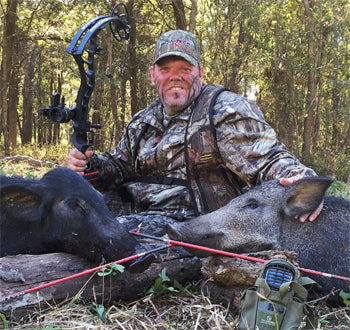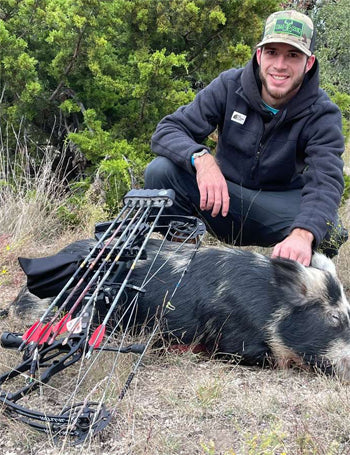Ghillie Suit Shop Blog RSS
What type of arrow is used for wildboar hunting?
But, is it enough with regular bow and arrow equipment to take down a wildboar?
The answer is not. Since these are aggressive, fast, and almost armored animals because of their thick fat layer, special equipment is required to succeed, otherwise,

you might harm the pig without killing it, rendering the creature a menace for your own safety, moreover, you might end up being the hunted!
Then, let's see the basics about arrows when we are intending to catch a wild pig.
By Head Type:
Broadhead arrows:
These arrows feature wide, sharp blades designed to inflict maximum internal damage. Common types include chisel, bodkin, and spear points. Choose materials like steel or high-carbon steel for better penetration.
Bodkin arrows:
These have slender, needle-like tips with minimal cutting surface. They excel at puncturing through tough hide and bone, making them ideal for reaching vital organs.
Barbed arrows:
These have backward-facing barbs on the head that prevent easy removal from the boar's flesh. This can cause additional internal bleeding and discourage the animal from running far after being hit.
Basics about Decoys for Deer Hunting
So, in order to use this resource in your favor, let's take a look at some basic information about the best way for the use of decoys during deer hunting as well as

a few words about regulations.
First of all, keep in mind to prioritize safety, ethics, and responsible hunting practices, afterwards...
Before You Head Out:
Research: Familiarize yourself with the local hunting regulations and best practices for your target species and area. This includes understanding any restrictions on decoy use.
Seek Knowledge: Consult with experienced hunters or wildlife officials for guidance on legal and ethical decoy deployment techniques in your specific context.
Safety First: Always prioritize safety in your hunting activities.
Ensure your decoys are positioned in a way that minimizes risk to yourself and others.
Setting the Scene:
Natural Placement: Mimic natural deer behavior by placing your decoys in areas where deer would typically graze, rest, or socialize. Consider factors like terrain, cover, and natural feeding patterns.
Variety is Key: Mix up your decoy types and postures to create a more realistic scene. Use a combination of standing, feeding, and resting postures to appeal to different deer instincts.
Distance Matters: Position your decoys at an appropriate distance for the species you're targeting. Avoid placing them too close to your hunting position, as this can spook the deer.
Wind Direction: Consider the wind direction when setting up your decoys. Deer often use their sense of smell to navigate, so position your decoys downwind from your hunting position.
Is it luring legal for hunting?
Baiting:
This involves placing food or other attractants in an area to lure animals. Baiting is often illegal for hunting certain game animals, as it can be considered to be unsportsmanlike or give the hunter an unfair advantage.
However, baiting may be allowed for hunting some non-game animals or in certain circumstances, such as for pest control.

Scent luring:
This involves using scents, such as urine or other natural attractants, to lure animals. Scent luring is generally legal, but there may be restrictions on the types of scents that can be used.
Here are some additional factors that may affect the legality of luring:
The type of animal you are hunting:
Some jurisdictions have different rules for different species.
The location where you are hunting:
Some areas may have special restrictions on luring.
The method of hunting:
Some methods of hunting, such as using artificial lights, may be illegal in conjunction with luring.
It is always best to err on the side of caution and avoid luring unless you are certain it is legal in the jurisdiction where you are hunting.
Violating hunting laws can result in fines, penalties, and even the loss of your hunting privileges.
Wildboar bow hunting, the ultimate challenge
Baiting and Using Scent
Baiting and using scent can be effective ways to attract wild boars to a hunting area. Corn, milo, and other grains are popular baits for wild boars. Bait should be placed in an area where wild boars are known to be active, such as near a wallow or feeding area.

Scent can also be used to attract wild boars. Hog urine, estrus sow scent, and synthetic boar scents are all effective attractants. The scent should be placed in an area where you want to ambush the boar, such as near a trail or bait pile.
Stalking and Ambushing Wild Boars
Stalking and ambushing wild boars are two common hunting techniques. Stalking involves slowly and carefully moving through the woods in search of wild boars. Ambushing involves waiting in a concealed spot for wild boars to come by.
When stalking wild boars, it is important to be aware of the wind direction. Wild boars have a keen sense of smell, so you want to make sure the wind is blowing in your favor. It is also important to move slowly and quietly. Wild boars are easily spooked, so any loud noises or sudden movements will send them running.
What you need to know to begin with deer calling
Find the right location:
Deer are most active in areas with good cover, such as woods, thickets, and

swamps. They are also more likely to be active in the morning and evening hours.
Use the right calls:
There are several different deer calls available, each of which mimics a different deer vocalization. Some of the most common deer calls include grunt calls, doe bleats, and buck snorts.
Start with a grunt call:
Grunt calls are one of the most versatile deer calls and can be used to attract both bucks and does. Start by making a series of short, soft grunts, and then increase the volume and intensity of the grunts as you go.
Use a doe bleat call:
Doe bleat calls are used to mimic the sound of a doe in distress. This can attract a buck that is looking for a mate or a predator that is looking for prey.








